ASUS F2A85-V Pro Review: A Look at FM2 with A85X
by Ian Cutress on October 10, 2012 11:20 AM EST- Posted in
- Motherboards
- Asus
- Trinity
- FM2
- A85X
3D Movement Algorithm Test
The algorithms in 3DPM employ both uniform random number generation or normal distribution random number generation, and vary in various amounts of trigonometric operations, conditional statements, generation and rejection, fused operations, etc. The benchmark runs through six algorithms for a specified number of particles and steps, and calculates the speed of each algorithm, then sums them all for a final score. This is an example of a real world situation that a computational scientist may find themselves in, rather than a pure synthetic benchmark. The benchmark is also parallel between particles simulated, and we test the single thread performance as well as the multi-threaded performance.
It should be noted that this benchmark is a purely floating point benchmark, indicative of a lot of research written code where several months of optimization is not possible or not common knowledge within the research group. The compiler is not clever enough to convert what is expected into appropriate integer conversions, so Bulldozer and Piledriver based processors will only perform as well as their singular FPU units per module will allow. The benchmark is unaffected by memory speed as thread creation is created on the CPU and all data created fits well within the L2 cache per core.
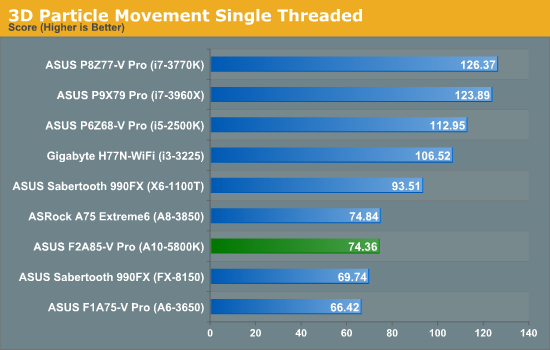
In the single threaded test, a lot of conclusions can be drawn from the comparison of AMD architectures. Direct comparison of Piledriver to Bulldozer (A10-5800K to FX-8150) gives a boost in single core performance of 7%, however comparing the old Stars cores of the A8-3850 at 2.9 GHz is roughly the same as the new Piledriver core at 4.2 GHz. So even with a 1.3 GHz advantage, Piledriver is only as good as Stars and less efficient in floating point results. If we compare Piledriver to Thuban, i.e. A10-5800K to X6 1100T, the Piledriver core gets stomped on by a good 25% performance. I find this quite staggering – most of the code I ever encountered as a computational chemist was floating point based, dealing with single and double precision on a regular basis. On this result, I would steer clear of Piledriver.

The multithreaded version of 3DPM is slightly tougher to analyze. Due to the FP nature of the program, the A10-5800K is essentially a 2 core FPU processor, whereas all the other comparative AMD processors have either 4 or 6 FPUs to play with. What is perhaps worth considering is that the Bulldozer processor with 4 modules scores 326.32, whereas the Piledriver processor with only 2 modules scores 203.06, which is more than half. This would mean that the Piledriver core actually achieves 20% better performance at the same frequency, despite our ST test giving Piledriver only a 7% increase. Part of this could be put down to the architecture improvements – improved scheduling for heavily threaded loads, one of the downfalls of Bulldozer but was improved in Piledriver could be the reason here.
WinRAR x64 3.93 - link
With 64-bit WinRAR, we compress the set of files used in the USB speed tests. WinRAR x64 3.93 attempts to use multithreading when possible, and provides as a good test for when a system has variable threaded load. If a system has multiple speeds to invoke at different loading, the switching between those speeds will determine how well the system will do. WinRAR is also very sensitive to memory speeds and subtimings.
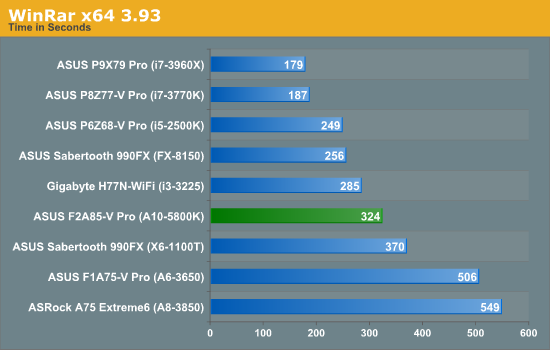
Analyzing the WinRAR results can be a little confusing, given that at different points of our previous testing the memory settings have been different (should point out that they have been consistent when comparing against like-for-like). When the A10-5800K was playing ball with DDR3-2400 10-12-12 memory, the WinRAR copy test pulled out miles ahead of the Thuban and Llano processors by a good margin. However the Sandy Bridge i5-2500K, with 4 INT and 4 FPU units gave the Trinity processor a proverbial thrashing despite being limited to DDR3-1333 at the time of testing.
FastStone Image Viewer 4.2 - link
FastStone Image Viewer is a free piece of software I have been using for quite a few years now. It allows quick viewing of flat images, as well as resizing, changing color depth, adding simple text or simple filters. It also has a bulk image conversion tool, which we use here. The software currently operates only in single-thread mode, which should change in later versions of the software. For this test, we convert a series of 170 files, of various resolutions, dimensions and types (of a total size of 163MB), all to the .gif format of 640x480 dimensions.
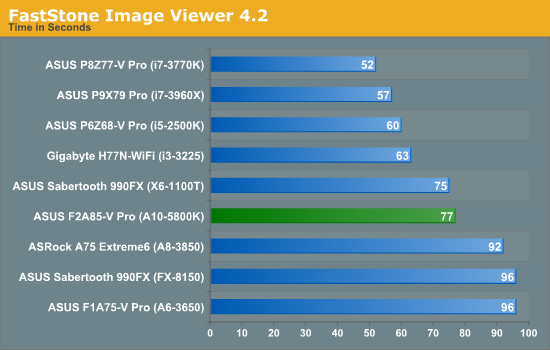
In the FastStone results, we see the Piledriver processor beat the Bulldozer and Stars cores by a considerable margin, and nudge the Thuban as well.
Xilisoft Video Converter
With XVC, users can convert any type of normal video to any compatible format for smartphones, tablets and other devices. By default, it uses all available threads on the system, and in the presence of appropriate graphics cards, can utilize CUDA for NVIDIA GPUs as well as AMD APP for AMD GPUs. For this test, we use a set of 32 HD videos, each lasting 30 seconds, and convert them from 1080p to an iPod H.264 video format using just the CPU. The time taken to convert these videos gives us our result.
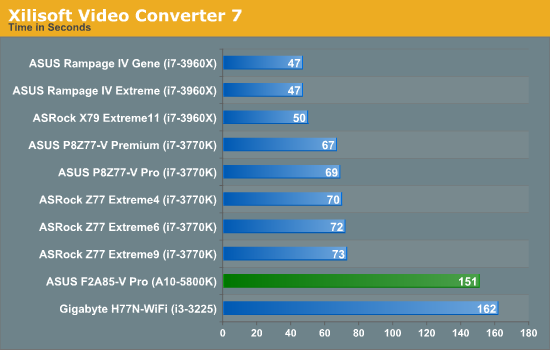
Unfortunately our Xilisoft benchmark is rather new, and thus we do not have results for all the AMD cores we have used in the past. However if we compare the A10-5800K directly with the i3-3225, we unfortunately have a memory difference to contend with (DDR3-2133 vs. DDR3-1600). With that being said, it is clear that video conversion is an INT process and all four of the A10-5800K INT units are being used.
x264 HD 4.0.1 Benchmark
The x264 HD Benchmark uses a common HD encoding tool to process an HD MPEG2 source at 1280x720 at 3963 Kbps. This test represents a standardized result which can be compared across other reviews, and is dependant on both CPU power and memory speed. The benchmark performs a 2-pass encode, and the results shown are the average of each pass performed four times.
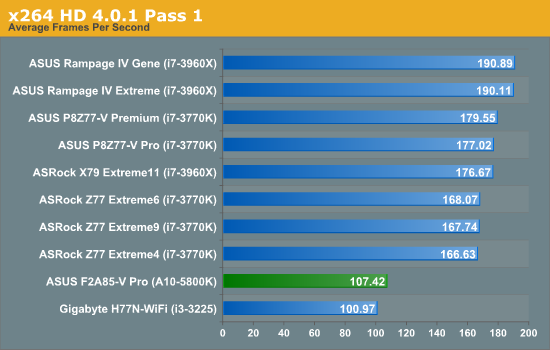
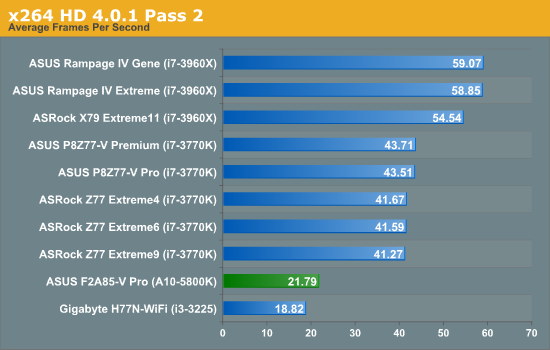










66 Comments
View All Comments
andykins - Wednesday, October 10, 2012 - link
A 2500k fits into socket 1155, not 1156 - the latter is Nehalem I believe?Old_Fogie_Late_Bloomer - Wednesday, October 10, 2012 - link
Likewise, the features chart on the first page lists PCIe 3.0 slots...Trinity has PCIe 2.0...IanCutress - Wednesday, October 10, 2012 - link
Apologies - first one was a brain fart, second was carry over. Tables like that I have to write in HTML (via excel) then copy paste in. Somehow got a weird mishmash of the last review and the new one.Ian
Kevin G - Wednesday, October 10, 2012 - link
First page, second paragraph:"Thus if I purchase an i7-3960X today, I know that it will fit into Socket 2011 based motherboards - similarly with the i5-2500K, it will fit into Socket 1156 motherboards. "
The i5-2500K fits into socket 1155.
Anonymous Blowhard - Wednesday, October 10, 2012 - link
> This full sized ATX board is aiming for the enthusiast in the Trinity space> enthusiast in the Trinity space
> enthusiast
> Trinity
Nope
djshortsleeve - Wednesday, October 10, 2012 - link
Well, AMD fanboi enthusiast maybejust4U - Wednesday, October 10, 2012 - link
I am not AMD fanboi but I am a fan of new computer hardware. As such I tend to grab some of the latest stuff. The thing about AMD boards (that I've noticed) is to get something comparable from Intel your usually looking at 30-50 more. Their boards are feature rich at a lower premium.This board in particular, (and Gigabyte's alternative) is over priced. I'd say by 20 bucks. But it's new hardware, slight price premium.. I expect in coming months this board will be 110-120 and the CPU it's paired with will drop to in and around the same price.
CeriseCogburn - Saturday, October 13, 2012 - link
LOL - caught again, and still in public denial.The gaming benchmark page is a shame to the human race and all reporters worldwide, but that's how amd corpo pig pressure rolls.
medi01 - Sunday, October 14, 2012 - link
Do you at least get payed by Intel?Utterly stupid to post so much shit for them for free...
darcotech - Thursday, October 11, 2012 - link
I totally agree.I consider myself more leaning toward AMD,but Trinity has no place in enthusiast world.
It was made as low to medium all-in-one (cheap) solution and as such, it works great.
Why would anyone put mid-high end GPU with trinity is beyond my imagination.
Even if you say you start with Trinity, then add G-card doesn't hold the true, because your CPU performance will suffer.Better start with strong CPU (probably Intel) and basic graphics card, and then later add something much stronger.At the end,you will have strong system.
150USD for Trinity oriented motherboard is not overkill.It is plain stupid.